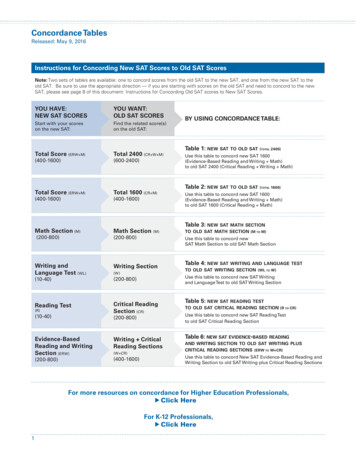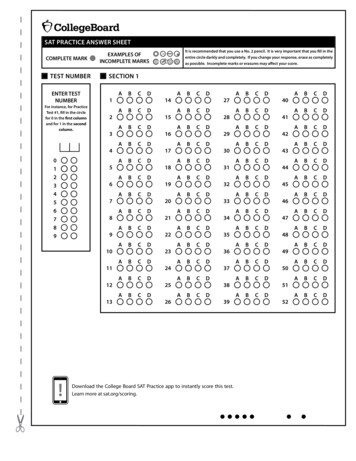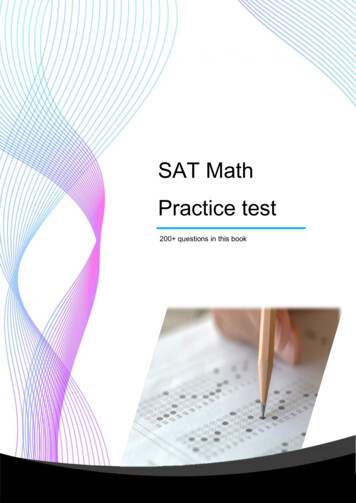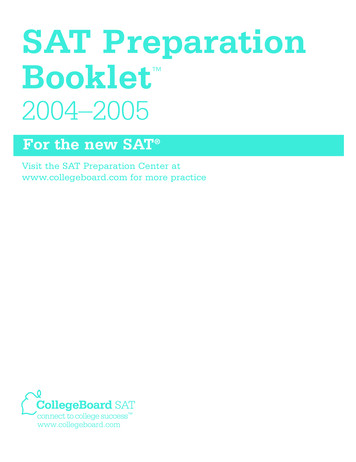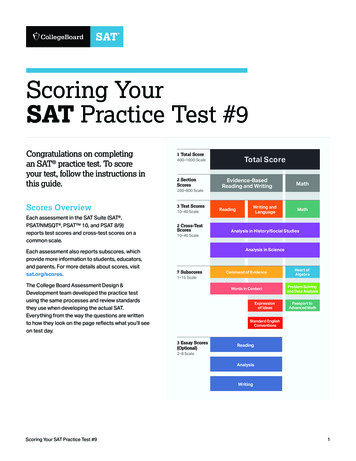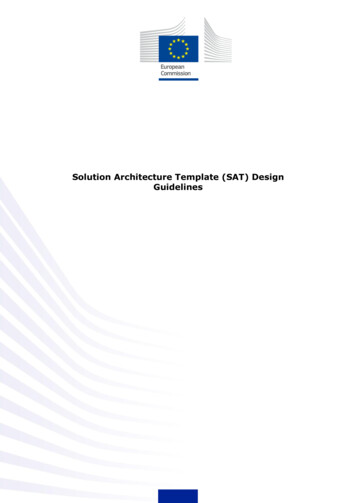
Transcription
Solution Architecture Template (SAT) DesignGuidelines
Solution Architecture Template (SAT) Design Guidelines v2.0.0Change controlModificationDetailsVersion 2.0.0Alignment with EIRA v2.0.0Version 1.0.0Initial versionISA² Action - European Interoperability ArchitecturePage 1 of 25
Solution Architecture Template (SAT) Design Guidelines v2.0.0ArchiMate and TOGAF are registered trademarks of The Open Group.ArchiMate and TOGAF are copyright of The Open Group. All rights reserved.Archi is a registered trademark of Phillip Beauvoir.ISA² Action - European Interoperability ArchitecturePage 2 of 25
Solution Architecture Template (SAT) Design Guidelines v2.0.0Table of Contents1INTRODUCTION . 41.11.21.32INTRODUCTION TO SOLUTION ARCHITECTURE TEMPLATES. 52.12.22.32.43PURPOSE OF THIS DOCUMENT . 4TARGET AUDIENCE . 4FURTHER INFORMATION. 4THE EUROPEAN INTEROPERABILITY REFERENCE ARCHITECTURE . 5WHAT IS A SOLUTION ARCHITECTURE TEMPLATE . 6BENEFITS OF AN SAT. 7HOW CAN AN SAT BE USED? . 7WHAT ARE THE GUIDELINES OF DESIGNING A SOLUTION ARCHITECTURE TEMPLATE? . 83.13.23.33.43.53.6EIRA VIEWS - DESIGN GUIDELINES. 8ARCHITECTURE BUILDING BLOCKS - DESIGN GUIDELINES . 8SOLUTION BUILDING BLOCKS - DESIGN GUIDELINES . 9INTEROPERABILITY SPECIFICATIONS - DESIGN GUIDELINES. 10ARCHIMATE MOTIVATION EXTENSION . 12NARRATIVES . 144TOOLING SUPPORT .155SAT DEVELOPMENT LIFECYCLE .165.1 INITIATION OF AN SAT. 165.1.1Perform a preliminary assessment . 165.2 GET APPROVAL TO DEVELOP THE SAT . 165.3 DESIGNING THE SAT . 165.3.1Define motivation and use-cases . 175.3.2Identify and document your target audience . 175.3.3Identify the required EIRA’s building blocks . 175.3.4Create a blueprint . 185.3.5Identify existing entities that should be reused . 195.3.6Add interoperability specifications . 195.3.7Add a narrative to each view . 205.4 PUBLISHING THE SAT . 205.5 SAT CHANGE MANAGEMENT . 216CONCLUSION .22APPENDIX: DESIGN GUIDELINES .23APPENDIX: GLOSSARY .24APPENDIX: ACKNOWLEDGEMENTS .25ISA² Action - European Interoperability ArchitecturePage 3 of 25
Solution Architecture Template (SAT) Design Guidelines v2.0.01 INTRODUCTION1.1 Purpose of this documentThis document explains the purpose of a Solution Architecture Template (SAT) and how to designone. It starts by explaining what the use-cases of the EIRA are, how an SAT can be used incertain of those use-cases and what the benefits of an SAT are. The different steps on how tocreate and use an SAT are explained afterwards.This document gives a small introduction to the EIRA , the document does not try to explain theEIRA in depth, nor how the EIRA can be used, however. Detailed information on the EIRA is available on the Joinup page1.1.2 Target audienceThis document targets enterprise/solution architects involved in the design of SAT’s based on theEIRA .1.3 Further informationThis document is part of the EIRA support series, more information on the EIRA itself can befound on the Joinup page2. This page provides download links to the EIRA modelled usingArchiMate , the overview document that explains the EIRA and tooling support is available viathe CarTool 3. Finally, the following four SATs (beta versions at the time of the writing of thisdocument) are available as well:123 Open Data SAT (v1.0.0 beta) eHI SAT (v1.0.0 beta) – Human Interfaces eID SAT (v1.0.0 beta) eDelivery SAT (v1.0.0 joinup.ec.europa.eu/asset/eia/asset release/cartography-tool-v100ISA² Action - European Interoperability ArchitecturePage 4 of 25
Solution Architecture Template (SAT) Design Guidelines v2.0.02 INTRODUCTION TO SOLUTION ARCHITECTURE TEMPLATES2.1 The European Interoperability Reference ArchitectureThe Solution Architecture Templates that are described in this document are based on the“European Interoperability Reference Architecture (EIRA )”, a four-view reference architecturefor delivering interoperable digital public services across borders and sectors. It defines therequired capabilities for promoting interoperability as a set of architecture building blocks (ABBs).The EIRA has four main characteristics: Common terminology to achieve a minimum level of coordination: It provides a setof well-defined ABBs that provide a minimal common understanding of the most importantbuilding blocks needed to build interoperable public services. Reference architecture for delivering digital public services: It offers a frameworkto categorise (re)usable solution building blocks (SBBs) of an e-Government solution. Itallows portfolio managers to rationalise, manage and document their portfolio of solutions. Technology- and product-neutral and a service-oriented architecture (SOA)style: The EIRA adopts a service-oriented architecture style and promotes ArchiMate as a modelling notation. In fact, the EIRA ABBs can be seen as an extension of the modelconcepts in ArchiMate . Alignment with EIF and TOGAF : The EIRA is aligned with the New EuropeanInteroperability Framework (EIF)4 and complies with the context given in the EuropeanInteroperability Framework – Implementation Strategy (EIF-IS)5. The views of the EIRA correspond to the interoperability levels in the EIF: legal, organisational, semantic andtechnical interoperability. Within The Open Group Architecture Framework (TOGAF )6 andthe Enterprise Architecture Continuum, EIRA focuses on the architecture continuum. Itre-uses terminology and paradigms from TOGAF such as architecture patterns, buildingblocks and views.The EIRA uses views to model the different aspects of interoperability. Although interoperabilityalmost always involves exchanging data between ICT systems, interoperability is a wider conceptand encompasses the ability of organisations to work together towards mutually beneficial andcommonly agreed goals. The different views that are used to express this interoperability are“Legal view”, “Organisational view”, “Semantic view” and “Technical view”. An additional viewcalled “EIF Underlying Principles view” contains goals and principles that describe the context inwhich European public services are designed and implemented.4https://ec.europa.eu/isa2/eif en5http://eur-lex.europa.eu/resource.html?uri 2/DOC 1&format se/togafISA² Action - European Interoperability ArchitecturePage 5 of 25
Solution Architecture Template (SAT) Design Guidelines v2.0.0The EIRA uses the following key elements in the development of specific solutions: EIRA view: The EIRA consists of several views, including one view for each of the EIFinteroperability levels. EIRA viewpoints: The EIRA defines several viewpoints containing a selection ofbuilding blocks from the different views, to address the needs of specific stakeholders.SATs should include at least the High-level viewpoint, which provides an introductory viewby highlighting the focal ABBs of the SAT. Architecture Building Block: Based on the TOGAF definition, an architecture buildingblock is an abstract component that captures architecture requirements and that directsand guides the development of solution building blocks. An ABB represents a (potentiallyre-usable) component of legal, organisational, semantic or technical capability that can becombined with other architecture building blocks. An architecture building block describesgeneric characteristics and functionalities. Architecture building blocks are used to describereference architectures, solution architecture templates or solution architectures of aspecific solutions. Solution Building Block: Based on the TOGAF definition, a solution building block is aconcrete element that implements the required capabilities of one or more architecturebuilding blocks. On the technical view, a solution building block is a specific product orsoftware component.More information on the EIRA can be found on Joinup7 where documentation is available, themodel can be downloaded and other supporting material like the CarTool and other SATs areavailable for consultation.2.2 What is a solution architecture templateA Solution Architecture Template (SAT) is a specification extending the EIRA providing supportto solution architects in a specific solution domain in the form of a template that can be used todesign related solutions. An SAT contains the following elements:7 A motivation in the form of principles and requirements. A goal and a description of the supported functionalities. A sub-set of the EIRA core Architecture Building Blocks (ABBs) covering the four EIFlayers. A set of specific ABBs extending EIRA 's views enabling specific functionalities to beprovided by implementations derived from the SAT. The interoperability specifications of selected ABBs and a narrative for each EIRA view.https://joinup.ec.europa.eu/asset/eia/ISA² Action - European Interoperability ArchitecturePage 6 of 25
Solution Architecture Template (SAT) Design Guidelines v2.0.02.3 Benefits of an SATThe benefits of a SAT are the following: Provides architects with a common approach to cope with a specific interoperabilitychallenge. It also places the focus on the key-points you need to consider when building asolution in a specific problem area. An architect can create a solution architecture by mapping existing Solution Building Blocks(SBBs) to an SAT, based on the interoperability specifications that are provided. This isdone by realising the ABBs identified in the SAT by specific SBBs. When an architect creates an SAT, he/she can define the interoperability specifications forthe SAT’s ABBs and moreover recommend specific SBBs so that the selection of specificsolutions is facilitated and is ensured to have more interoperable results. An SAT can be created within and across the different views of the EIRA . An SAT canthen support architects specialised in different interoperability levels.2.4 How can an SAT be used?An SAT can be used in the following ways: As a tool to help you design your solution. An SAT serves as blueprint for architectsto build solutions and guides them in indicating the elements, which should beimplemented as well as the elements that are already available and should be taken intoaccount. These elements can have a legal bases, can apply to organisational processes orcan have a technical nature. As guideline of explicit requirements that need to be met: An SAT can also be usedin procurement and call for tender procedures where the EIRA is used as specification insuch a way the EIRA is used as controlled vocabulary and the interoperabilityspecifications serve as a checklist for interoperability requirements.ISA² Action - European Interoperability ArchitecturePage 7 of 25
Solution Architecture Template (SAT) Design Guidelines v2.0.03 WHAT ARE THE GUIDELINES OF DESIGNING A SOLUTION ARCHITECTURETEMPLATE?A Solution Architecture Template is provided in the form of a document containing the modelbased on ArchiMate as well as a narrative describing the models. Furthermore, the documentdescribes the context, has a glossary and references to other resources or resources that havebeen used in the model.The model of the SAT itself is described in views using Architecture Building Blocks (ABBs),Solution Building Blocks (SBBs), Interoperability specifications, elements from the ArchiMate motivation extension and a narrative. These aspects are described in the following sections.3.1 EIRA views - design guidelinesDesign guideline #1: All of the EIRA views should be covered in an SAT.A Solution Architecture Template (SAT) is based on the EIRA and therefore you can expect tofind all of the EIRA views in your SAT as well as the High-level viewpoint. The views andviewpoints you want to model are the following: High-level viewpoint Legal View Organisational View Semantic View Technical view – application Technical view – infrastructureDesign guideline #2: The focal building blocks in the high level viewpoint should be included.On each of the views, you will typically want to model the focal building blocks in either the formof an Architecture Building Block (ABB) or a Solution Architecture Building (SBB), these areexplained in the next sections. For most of the building blocks, you want to indicate a ts etc. for which the ArchiMate motivation extension can be used.Finally, each view will have a narrative giving a textual explanation of that specific view.3.2 Architecture Building Blocks - design guidelinesTOGAF mentions the following8: Architecture Building Blocks (ABBs) capture architecturerequirements; e.g., business, data, application, and technology requirements and direct andguide the development of 9-doc/arch/chap37.htmlISA² Action - European Interoperability ArchitecturePage 8 of 25
Solution Architecture Template (SAT) Design Guidelines v2.0.0An SAT contains a selection of EIRA ABBs in each of its views that are of specific importance inthe context of the SAT and as such acts as requirements for the solution that will be developedbased on the SAT.Design guideline #3: A selection of the EIRA ABBs will be added as IoP requirements.Architecture Building Blocks can ‘specialise’ other Architecture Building Blocks, like is shown inthe following example coming from the Semantic View of the EIRA :This example indicates a ‘Data Standard’, modelled as an Architecture Building Block (indicatingthat it serves as requirement, the actual implementation in the form of an SBB is not indicatedin the example above), and it models two specialisations; a ‘Character Encoding Scheme’ and a‘Syntax Encoding Scheme’. This specialisation indicates that a ‘Character Encoding Scheme’ is amore specialised form of a ‘Data Standard’, the same applies for the ‘Syntax Encoding Scheme’.3.3 Solution Building Blocks - design guidelinesTOGAF mentions the following9: Solution Building Blocks (SBBs) may be either procured ordeveloped. They define what products and components will implement the functionality, definethe implementation, fulfil business requirements and are product or vendor-aware.Design guideline #4: Existing solutions or implementations will be added in the form of SBBs,realizing the EIRA ABBs.In an SAT, we specify both the ABB and the SBB for a specific implementation of a requirement.As example we use the ‘Character Encoding Scheme’ as part of a solution. The use of this ABBtells us that we must use a ‘Character Encoding Scheme’ in our solution. The actualimplementation in the form of an SBB additionally tells us which implementation to use; ‘UTF-8’in this specific gaf9-doc/arch/chap37.htmlISA² Action - European Interoperability ArchitecturePage 9 of 25
Solution Architecture Template (SAT) Design Guidelines v2.0.0When looking at the name of the SBB, you can see that it is annotated (using the followingstyle: ‘ Implementation of ABB ’) with the name of the ABB that it actually implements.Creation of such annotations can be facilitated through appropriate tooling, such as the CarTool ,described in the chapter on tooling support, an EIRA -focused extension to the popular Archi tool.103.4 Interoperability Specifications - design guidelinesAn Interoperability Specification is a document containing agreed normative statements forsolution building blocks used in an information exchange context. It can refer to existing standardsor specifications. An interoperability specification can also refer to (use) other interoperabilityspecifications.Interoperability specifications can be modelled in two ways; As a requirement for interoperability, the interoperability specification will be provided inthe form of an ABB. As an implementation of an interoperability specification, the interoperability specificationwill be provided in the form of an SBB (the solution) specialising an ABB (the requirement).Design guideline #5: Interoperability specifications are modelled as either requirement in theform of ABBs or as implementation of an interoperability specification in the form of an SBB.The SAT shall identify the ABBs that need interoperability specifications.10http://archimatetool.com/ISA² Action - European Interoperability ArchitecturePage 10 of 25
Solution Architecture Template (SAT) Design Guidelines v2.0.0As example; we see three technical interoperability specifications; HTML5, ECMAScript andCascading Stylesheets, all three are modelled as implementations of technical interoperabilityspecifications in the form of annotated SBBs, they extend technical interoperability specificationwhich is modelled as ABB. Additionally, we also include the notion that HTML5 refers to the twoother specifications.In most cases, only the top-level interoperability specification is used (HTML5 in the case of theexample), but for clarification purposes, it can sometimes be more convenient to include areference to other specifications as well.ISA² Action - European Interoperability ArchitecturePage 11 of 25
Solution Architecture Template (SAT) Design Guidelines v2.0.0To describe the interoperability requirement precisely, The “Interoperability Specification”building block is defined by the following attributes:Attribute nameDescriptionIDInternal key used to identify an architecture building blockdct:typeThe type of the architecture building blockdct:publisherThe name of the individual or organisation that is documenting the currentbuilding blockdct:modifiedThe date that the information documented for this building block was lastmodifiedeira:urlThe URL at which the specification can be referenced onlineeira:identifierThe identifier is unique. It identifies univocally the specification in theCartographyeira:bodyThe body contains statements on one or several Building Blocks. It informseither (i.e. proposed mode) on the proposed specification at the ABB levelto achieve interoperability for its SBBs or (i.e. in solution descriptivemode) on a specification to which an SBB is actually compliant to achieveinteroperabilityDesign guideline #6: The interoperability specifications should document the followingattributes: ID, dct:type, dct:publisher, dct:modified, eira:url, eira:identifier and eira:body.3.5 ArchiMate Motivation ExtensionThe motivation extension is used to model specific goals, principles, requirements and/orconstraints and optionally also the sources of those intentions; stakeholders, drivers andassessments. Motivational concepts are used to model the motivations, or reasons, that underliethe design or change of a given enterprise architecture. These motivations influence, guide, andconstrain the design.Design guideline #7: The ArchiMate motivation extension is used to model motivationalconcepts and their sources.It is essential to understand the factors, often referred to as drivers, which influence themotivational elements. They can originate from either inside or outside the enterprise. Internaldrivers, also called concerns, are associated with stakeholders, which can be some individualhuman being or some group of human beings, such as a project team, enterprise, or society.ISA² Action - European Interoperability ArchitecturePage 12 of 25
Solution Architecture Template (SAT) Design Guidelines v2.0.0The actual motivations are represented by goals, principles, requirements, and constraints. Goalsrepresent some desired result – or end – that a stakeholder wants to achieve; e.g., increasingcustomer satisfaction by 10%. Principles and requirements represent desired properties ofsolutions – or means – to realize the goals. Principles are normative guidelines that guide thedesign of all possible solutions in a given context.11The following concepts are available in the ArchiMate motivation extension:Non-EIRA conceptDescriptionA principle is defined as a normative property of all systems in a givencontext.A requirement is defined as a statement of need that must be realizedby a system.A goal is defined as an end state that a stakeholder intends to achieve.A constraint is defined as a restriction on the way in which a system isrealized.A stakeholder is defined as the role of an individual, team, ororganization (or classes thereof) that represents their interests in, orconcerns relative to, the outcome of the architecture.A driver is defined as something that creates, motivates, and fuels thechange in an organizationAn assessment is defined as the outcome of some analysis of e/archimate2-doc/chap10.htmlISA² Action - European Interoperability ArchitecturePage 13 of 25
Solution Architecture Template (SAT) Design Guidelines v2.0.0Example of the ‘Resource Description Framework (RDF)’ as implementation of a ‘SemanticInteroperability Specification which has a principle attached (the ‘Linked Data Principle’)3.6 NarrativesDesign guideline #8: The models are completed using narratives, a textual description thatexplains the context, the building blocks and their relationships.Narratives are descriptions that provide more insight into the model by giving a textual andhuman readable description of the context of the view, each building block in the view, its purposeand its relationship to the other building blocks. The link to interoperability specifications that arelinked to the building blocks should also be described. The narratives are provided as descriptionin the ArchiMate model itself and also as text accompanying the model in the final document.Design guideline #9: Narratives are provided as description in the model itself as well asaccompanying text in the final document.ISA² Action - European Interoperability ArchitecturePage 14 of 25
Solution Architecture Template (SAT) Design Guidelines v2.0.04 TOOLING SUPPORTThe CarTool 12 is a tool built by the European Commission’s ISA unit designed to provide supportin using the European Interoperability Reference Architecture (EIRA ) and accessing a portfolio(Cartography) of solutions that are documented using the EIRA . It is built as a plug-in for thepopular open source ArchiMate modelling tool Archi , building upon its modelling capabilitiesand providing higher level EIRA support. The CarTool itself is open-source13 and distributedunder the ISA non-commercial licence which is available on the Joinup page14.From a high-level perspective the CarTool enables you with the following features when workingwith SATs:121314 Inspect the EIRA ’s views, ABBs and attributes, including their documentation. Thiscan be done both in graphical mode, by viewing the EIRA ’s views, or in tabular formallowing searching and sorting. Inspect the content of all Cartography solutions and SATs. Similar to the EIRA this can be done both in graphical and tabular mode. Create or modify solutions and SATs by adding to them SBBs (and also ABBs in thecase of SATs), from the EIRA , SATs or other solutions. Consult proposed and used interoperability specifications to find conformant SBBsfrom the Cartography and include them, and related specifications, to solutions and SATs.https://joinup.ec.europa.eu/asset/eia/asset a/descriptionISA² Action - European Interoperability ArchitecturePage 15 of 25
Solution Architecture Template (SAT) Design Guidelines v2.0.05 SAT DEVELOPMENT LIFECYCLEThe lifecycle of an SAT follows the classical stages a lifecycle model: Plan, Build, Deliver and Run.We can map these stages to the SAT lifecycle as follows: Plan; initiation phase; perform an assessment and get approval to develop the SAT. Build: design the SAT. Deliver: publish the SAT. Run: use the SAT, collect feedback and apply a change management process.These different stages are explained in the following sections.5.1 Initiation of an SATThe initiation of an SAT implies performing an assessment and getting approval to develop theSAT.5.1.1 Perform a preliminary assessmentThe very first step in the lifecycle of an SAT is to produce a basic business case identifying thetarget users and value provided. Based on it, an assessment is performed - does it make senseto create an SAT for the solution area which you want to describe? The value shall be assessedin terms of the following aspects: The level of granularity (more generic versus more specific) The number of interoperability specifications that play a role at the predefined level ofgranularity.An SAT is only useful when there is a significant amount of interoperability specifications topromote the level of desired interoperability which is needed to promote cross-border reusability.When an SAT becomes too specific, it loses its value as a template. Keep in mind that if youattempt to make an SAT too specific it loses its value of a template.5.2 Get approval to develop the SATOnce the level of granularity and the expected number of interoperability specifications areestimated to provide enough detail to bring added value, an approval to develop the SAT shouldbe obtained. As example for the European Commission; the Directorate General (DG) that ownsthe public policy should accept the development of an SAT for the specific solution domain.5.3 Designing the SATDesigning an SAT is an iterative process. During this process, feedback should be obtained fromthe different stakeholders such as policy makers and subject matter experts in order to ensurethat the SAT represents state of the art, including all as
Detailed information on the EIRA is available on the Joinup page1. 1.2 Target audience This document targets enterprise/solution architects involved in the design of SAT's based on the EIRA . 1.3 Further information This document is part of the EIRA support series, more information on the EIRA itself can be found on the Joinup page2 .


